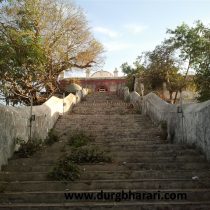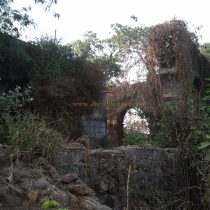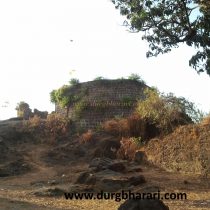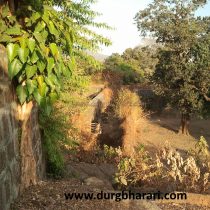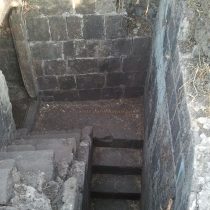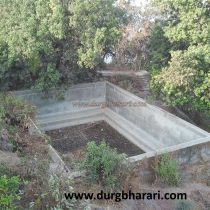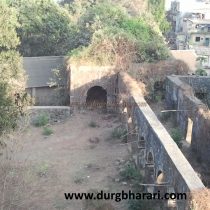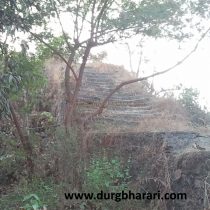GHODBUNDER
TYPE : COASTAL FORT
DISTRICT : THANE
HEIGHT : 0
GRADE : EASY
In the rapidly growing city of Mumbai and its environs, some forts are still struggling to survive. One of the major forts is Ghodbunder fort. Although most people know Ghodbunder on the Western Expressway, the Ghodbunder fort here is not very familiar to anyone except the trekkers. The fort is built on a small hill on the south bank of Ulhas Bay. Being close to Mumbai, there are many transport options to visit Ghodbunder fort. On the Western Expressway, on the way from Mumbai to Ahmedabad, one crosses the flyover near Dahisar Toll Naka and comes across a fork. If you go from the left path of this fork to the very end, you will reach Ghodbunder fort. There is a bus service from Borivali as well as Mira Road railway station to Ghodbunder village.
...
It takes 5 minutes to reach the fort from the village. On this road, you can see the Shiv temple built by Nana Shankarsheth. Most of the ground ramparts of Ghodbunder fort have been destroyed today. In the northern part of the fort, only the remains of the ramparts are visible, while the ramparts themselves are nowhere to be seen except in the western ramparts. Due to the poor condition of the ramparts, it is not known exactly where the main gate of the fort was. Now, we have to visit Ghodbunder fort in two parts. One is the part of the tourist accommodation built by the Maharashtra Tourism Board and the other is the part where you have to make your way through the village. In the first part of the fort, after climbing about 40 steps, you can see the old structure converted into a tourist accommodation by MTDC. Considering the overall size and construction of this building, it should be a church. There are a bastion and a small rampart in front of the creek. After seeing this part, get down and walk through some houses and come to another part of the fort. In the second part, we enter the fort through a broken entrance by climbing some newly built steps. Upon entering the fort, you can see a row of Portuguese style arches on the left, and on the right, you can see a 25x20 feet long and 10 feet deep water cistern dug in the ground. The cistern is modernized with cement plaster. At the front of the arch are five rooms measuring 15x15 feet and are currently cement plastered. On the right side of the building is a large round bastion built of wrought stone, separated from the ramparts. This bastion inside the fort is completely different and considering its height, it must have been built only for observation. The bastion has a door and a staircase on the inside to go up and a barn is present here. The design of the door on the inside of the bastion is unique and the door could be opened and closed by sliding it up and down through the notches up to the top of the bastion. Such a structure can also be seen at the entrance of Vasai Citadel. There is a door on the right side of the path with the steps of the bastion and inside it is a barn. The roof of the barn is the top of the bastion and this may have been used for storing guns and ammunition or for the patrolling soldiers to rest. From this staircase in the bastion, you enter directly to the top of the bastion. From the top of this bastion, Ulhaskhadi and the surrounding distant region can be seen. The northern ramparts of the fort are still standing but are overgrown with bushes. Steps have been built from the inside of the fort to reach the ramparts. Apart from this, other remains of the fort consist of the ruined altar and in some places the collapsed ramparts. One hour is enough to walk around the entire fort. In ancient times, Kalyan was known as an important port. Ships sailed from the Arabian Sea to the port of Kalyan via Ulhas Bay. Various forts like Vasai fort, Dharavi fort, Ghodbunder fort, Gaimukh fort, Naglabunder fort, Durgadi fort were built by different rulers to keep an eye on this waterway. There are many opinions about the origin of the name Ghodbunder. According to some, the trunk of the Sahyadri, which descends near Ulhas Bay, looks like a horse hence the fort was named Ghodbunder. According to some, the place was named Ghodbandar after Portuguese horses descended on it. But the place Ghodbunder is mentioned in the book Mahikavati's Bakhar, written in the 13th century before the Portuguese came to India. When the Portuguese built the fort of Vasai in 1530 AD, they built a network of forts like Gaimukh, Nagla Bunder, Thane, and Pimpalas to protect it and keep the trade route in the bay safe. They started the construction of this fort in the hilly area near the creek around 1550 AD. In Portuguese documents, the fort is referred to as Kakabe di Tanna, while in some foreign travelogues it is referred to as Hippakura. During Shivaji Maharaj’s period, the Ghodbunder fort was under the control of the Portuguese. In 1672, the fort was attacked by the Marathas but they couldn’t successfully capture the fort. Later, Sambhaji Maharaj brought this part of Palghar under his control but the fort remained in the possession of the Portuguese. When the Portuguese ruled the area until 1737, they built a church here which is now a tourist accommodation. Before the conquest of Vasai Fort, many battles were fought in this area between 1736 and 1738 and the Marathas conquered Ghodbunder fort along with Thane, Gaimukh, and Kamandurg forts. It is recorded that when the Marathas conquered the Ghodbunder fort, 250 Portuguese were killed and 7 ships were captured. This fort must have played an important role in the blockade of Vasai fort during the battle of Vasai. It is mentioned that Khandoji Mankar did some construction in the fort in 1738. In 1780, the fort came under the control of the British, but according to Salbai's treaty, the fort came under the control of the Marathas again. In the year 1818, like other forts in Maharashtra, this fort also went under the control of the British. The British made this fort the headquarters of the Thane district administration of the East India Company. The then Thane district is today's Palghar, Vasai, Mumbai, Mumbai suburbs, and some parts of Raigad district along with today’s Thane. The entire area was managed by a collector sitting in this fort. Currently, the fort is under the control of the Archaeological Department of India. The condition of the fort is bad but efforts are underway to renovate the fort.
© Suresh Nimbalkar

